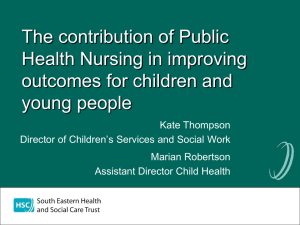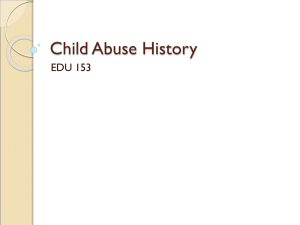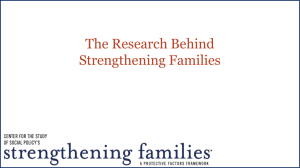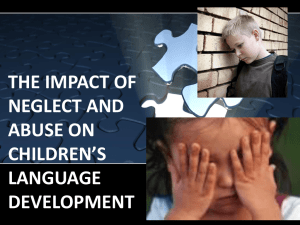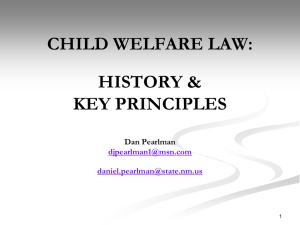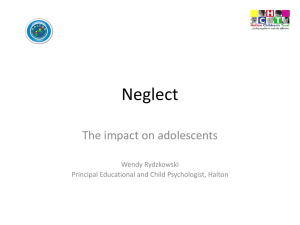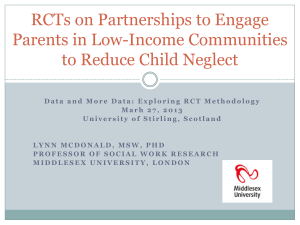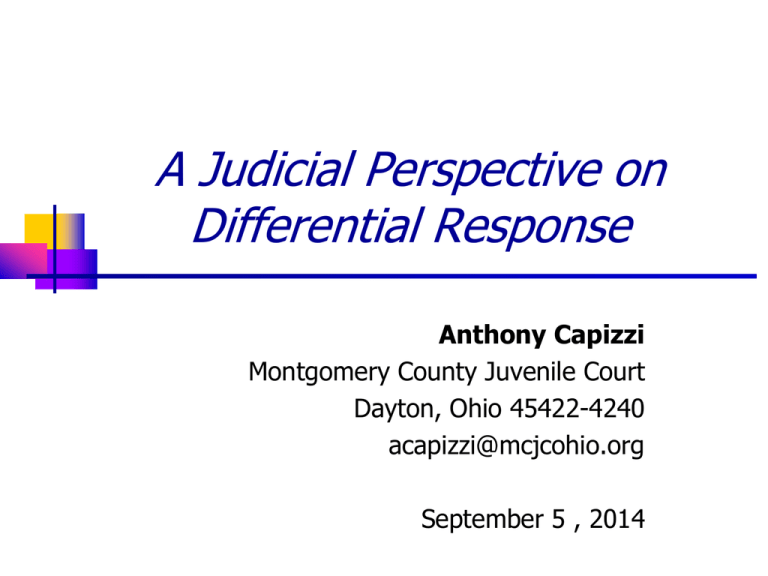
A Judicial Perspective on
Differential Response
Anthony Capizzi
Montgomery County Juvenile Court
Dayton, Ohio 45422-4240
acapizzi@mcjcohio.org
September 5 , 2014
Learning Objectives
Montgomery County Juvenile Court
• Who We Are and Goals to Work Towards
• The Statistical Reality
A Judicial Perspective on Differential Response
•
•
•
•
Differential Response
Ohio’s Differential Response System
A Different Approach: Alternative Response
Alternative Response – What? How? and Why?
Juvenile Court Goals
• Dedicated to administering laws in a just and equal manner.
• Must be the catalyst in rallying the entire community to protect
children by:
1) Being a leader in effective and
cost-efficient utilization of
community resources for the
treatment of children and families.
2) Protecting the community by
providing just and speedy
consequences.
3) Being sensitive and responsive to
individual victims and their
families.
The Statistical Reality
Montgomery County 2013
• One of Ohio’s 88 counties
• Population: 536,000 - Youth under 18 years: 138,000
• White persons: 73% - African-American persons: 20%
Montgomery County Juvenile Court
• Judges: 2 – Magistrates: 10
• Total Staff: 425
• Programs/Services: Official and Unofficial Court, Probation,
Detention, Intervention, CASA, Reclaiming Futures, Drug
Court, Start Right
MCJC Statistics by Year
Delinquency
Sex Offenses
Abuse, Neglect, & Dependency
2011
9,323
159
1,363
2012
9,988
180
1,043
2013
9,451
145
1,077
Custody/Visitation
Permanent Custody
Total
3,360
119
14,165
3,793
150
15,154
3,778
130
14,581
What is Differential Response?
Differential response is a child protection model
that:
• Uses two or more separate response pathways for accepted
reports of child abuse and neglect.
• Recognizes that an investigative response is not always the
most productive for the family or beneficial for the child.
• Provides an “alternative” to the traditional child protection
investigative response.
• Focuses on achieving safety through enhanced family
engagement.
Why Implement
Differential Response?
• The traditional child protection investigative response is
frequently perceived as overly adversarial or accusatory.
• The majority of investigations do not result in services being
provided.
• Focus on substantiation and identifying a perpetrator does
not contribute to a family’s readiness to engage in services.
• Differential response often results in greater success in
identifying, building, and coordinating both formal and
informal services and supports.
Implementation of
Differential Response in Ohio
• 2004 – Supreme Court of Ohio established the Subcommittee on
Responding to Child Abuse, Neglect, and Dependency to
develop and implement legislation to improve Ohio’s
system for accepting and investigating reports of child
abuse and neglect
• 2008 – Pilot programs in 10 of
Ohio’s 88 counties
• 2011 – Enactment of legislation
authorizing statewide
implementation
• 2014 – Statewide implementation
Elements Critical to the
Success of DR in Ohio
• Leadership and Prioritization
• Partnerships
• Shared sense of ownership
of and commitment to
desired outcomes
• Investment, specialized
supports and dedicated
resources
Ohio’s Differential Response System
Accepted Report of
Child Abuse/Neglect
Pathway Assignment
Alternative Response:
Safety and Family
Assessment
Family Not in Need
of (or Declines)
Service Model
ad
Exit
System
Family Agrees to
Service Model –
Family Engagement
and CommunityBased Services
Traditional Response:
Investigation
Unsubstantiated
Abuse/Neglect
ad
Exit
System
Substantiated
Abuse/Neglect
Transferred to an
Ongoing Unit –
Mandated Services
Alternative vs. Traditional Response
Alternative Response
• Child Safety, Permanency,
and Well-Being
• Assessment
• Agreement to Service Model
• Strengths/Needs Focused
• Family Engagement/Solution
Focused
• No Labels
• No Disposition
• One Worker
Traditional Response
• Child Safety, Permanency,
and Well-Being
• Investigation
• Mandated Service Model
• Incident Focused
• Rule Compliance
• Identification of Victim and
Perpetrator
• Disposition of Substantiated,
Indicated, or Unsubstantiated
• Multiple Workers
A Different Approach:
Alternative Response
The Goal
• Provide an alternative method of achieving child safety,
permanency, and well-being, in cases where child abuse/neglect
is reported.
It’s All About
•
•
•
•
•
•
•
Identifying Concerns and Finding Solutions
Not Assigning Blame or Finding Fault
Increased Family Contact
Access to Community Service Providers
Family Engagement and Collaboration
Attitude and Willingness to Work Together
Partnerships and Mutual Accountability
What is Alternative Response?
Alternative Response IS
• Child welfare practice that promotes child safety, well-being,
and permanency.
• Alternative service track for reports of child abuse/neglect.
• Flexible, family-centered, service model capable of meeting
the unique needs of each family.
• Comprehensive evaluation of child safety, risk of subsequent
harm, and family strengths/needs.
• Community approach to providing up-front services to each
family without formal determination of abuse or neglect.
What is Alternative Response?
Alternative Response IS NOT
• Service model for all families
• Replacement for current Child Welfare Investigation
Services
• Service option for abuse/neglect cases involving:
o Sex abuse
o Serious injury or hospitalization
o Charges of criminal abuse/neglect
How to Use Alternative Response
•
•
•
•
•
Non-confrontational initial family contact
Provide up-front support services
Engage the family – Strive towards a working partnership
Coordinate and involve service providers in the community
Remove barriers to the client-worker relationship
o Voluntary agreement to many services
o No labels or disposition
o Focus on family strengths and finding solutions – Not on
the incident
Why Use Alternative Response?
National, State, and Local Outcome Data Confirms:
• Child safety is NOT compromised
o Fewer children enter foster care
o No increase in repeat maltreatment calls
• Rapid implementation of up-front service
• Fewer court filings – courts have more time to focus on the
cases that actually require judicial involvement
• After implementation/training, length of Agency involvement
could be similar to Traditional Response (if not shorter)
• Improved client and staff satisfaction
To Honor Their Souls
Questions



